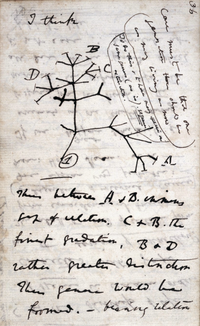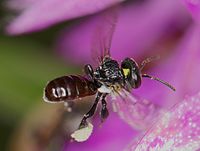
Do dung beetles show interrelated evolutionary trends in wing morphology, flight biomechanics and habitat preference?
Sign Up to like & getrecommendations! Published in 2018 at "Evolutionary Ecology"
DOI: 10.1007/s10682-018-9958-z
Abstract: In flying organisms, wing shape and biomechanical properties are recognized as key traits related to dispersal, foraging behavior, sexual selection and habitat preferences. To determine if differences in dung beetle wing shape and flight biomechanics… read more here.
Keywords: shape; biomechanics; analysis; wing shape ... See more keywords

Disentangling wing shape evolution in the African mayfly, Teloganodidae (Ephemeroptera)
Sign Up to like & getrecommendations! Published in 2019 at "Zoologischer Anzeiger"
DOI: 10.1016/j.jcz.2019.02.005
Abstract: Wings are one of the most important structures in the evolution of insects and winged insects are widely accepted as being monophyletic. In Ephemeroptera, wing structure and shape is important for interpreting taxonomic relationships. Morphological… read more here.
Keywords: mayfly; teloganodidae; shape; wing shape ... See more keywords

The Influence of Mimicry on Wing Shape Evolution in the Butterfly Papilio dardanus (Lepidoptera: Papilionidae)
Sign Up to like & getrecommendations! Published in 2018 at "Annals of the Entomological Society of America"
DOI: 10.1093/aesa/say045
Abstract: Abstract Throughout its range in Africa, Papilio dardanus Brown, 1776 (Lepidoptera: Papilionidae) displays femalelimited mimicry of multiple model species, and the absence of hind wing tails is an important component of their mimetic convergence. Nonmimetic… read more here.
Keywords: shape; hind wing; lepidoptera papilionidae; wing shape ... See more keywords

Mixed support for an alignment between phenotypic plasticity and genetic differentiation in damselfly wing shape
Sign Up to like & getrecommendations! Published in 2022 at "Journal of Evolutionary Biology"
DOI: 10.1111/jeb.14145
Abstract: The relationship between genetic differentiation and phenotypic plasticity can provide information on whether plasticity generally facilitates or hinders adaptation to environmental change. Here, we studied wing shape variation in a damselfly (Lestes sponsa) across a… read more here.
Keywords: phenotypic plasticity; wing shape; genetic differentiation; shape ... See more keywords

Unsteady aerodynamic analysis and effectiveness of bio-inspired flapping wings in V-formation flight
Sign Up to like & getrecommendations! Published in 2022 at "Proceedings of the Institution of Mechanical Engineers, Part G: Journal of Aerospace Engineering"
DOI: 10.1177/09544100221103020
Abstract: Several bird species have been observed to fly in V-formation, an arrangement which exploits aerodynamic features to allow the group to conserve energy when migrating over long distances without stopping and feeding. The use of… read more here.
Keywords: bio inspired; flapping wings; formation; wing shape ... See more keywords

Wing morphology predicts individual niche specialization in Pteronotus mesoamericanus (Mammalia: Chiroptera)
Sign Up to like & getrecommendations! Published in 2020 at "PLoS ONE"
DOI: 10.1371/journal.pone.0232601
Abstract: Morphological variation between individuals can increase niche segregation and decrease intraspecific competition when heterogeneous individuals explore their environment in different ways. Among bat species, wing shape correlates with flight maneuverability and habitat use, with species… read more here.
Keywords: variation; bat; wing shape; niche ... See more keywords

Geometric Morphometric Analysis of Wing Shape to Identify Populations of Apis mellifera in Camagüey, Cuba
Sign Up to like & getrecommendations! Published in 2023 at "Insects"
DOI: 10.3390/insects14030306
Abstract: Simple Summary Bees are one of the most important creatures on Earth because of their pollination processes, which contribute to food security and ecosystem maintenance. The practice of apiculture is regarded as secondary. Nonetheless, producers… read more here.
Keywords: apis mellifera; wing shape; geometric morphometric; mellifera ... See more keywords